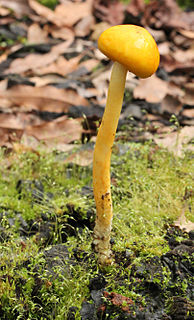
Chalciporus piperatus, commonly known as the peppery bolete, is a small pored mushroom of the family Boletaceae found in mixed woodland in Europe and North America. It has been recorded under introduced trees in Brazil, and has become naturalised in Tasmania and spread under native Nothofagus cunninghamii trees. A small bolete, the fruit body has a 1.6–9 cm orange-fawn cap with cinnamon to brown pores underneath, and a 4–9.5 cm high by 0.6–1.2 cm thick stipe. The flesh has a very peppery taste. The rare variety hypochryseus, found only in Europe, has yellow pores and tubes.

Hygrophoropsis aurantiaca, commonly known as the false chanterelle, is a species of fungus in the family Hygrophoropsidaceae. It is found across several continents, growing in woodland and heathland, and sometimes on woodchips used in gardening and landscaping. Fruit bodies (mushrooms) are yellow–orange, with a funnel-shaped cap up to 8 cm across that has a felt-like surface. The thin, often forked gills on the underside of the cap run partway down the length of the otherwise smooth stipe. Reports on the mushroom's edibility vary – it is considered poisonous, but has historically been eaten internationally.

Serpula lacrymans is one of the fungi that cause damage to timber referred to as dry rot. It is a basidiomycete in the order Boletales. The Serpula lacrymans has the ability to rapidly colonise sites through unique and highly specialised mycelium which also leads to greater degradation rates of wood cellulose.

Pulvinone, an organic compound belonging to the esters, lactones, alcohols and butenolides classes, is a yellow crystalline solid. Although the pulvinone is not a natural product, several naturally occurring hydroxylated derivatives are known. These hydroxylated pulvinones are produced by fungal species, such as the in Europe common Larch Bolete, or by moulds such as Aspergillus terreus.

Vulpinic acid is a natural product first found in and important in the symbiosis underlying the biology of lichens. It is a simple methyl ester derivative of its parent compound, pulvinic acid, and a close relative of pulvinone, both of which derive from aromatic amino acids such as phenylalanine via secondary metabolism. The roles of vulpinic acid are not fully established, but may include properties that make it an antifeedant for herbivores. The compound is relatively toxic to mammals.

Suillus variegatus, commonly called the velvet bolete or variegated bolete, is a species of edible mushroom in the genus Suillus. Like all bolete-like species it has tubes, and pores, instead of gills under its cap. The mushroom forms a mycorrhizal relationship with pine and occurs in North America and Eurasia.

Chalciporus is a genus of fungi in the family Boletaceae. There are approximately 25 species in the genus.

Hygrophoropsis is a genus of gilled fungi in the family Hygrophoropsidaceae. It was circumscribed in 1888 to contain the type species, H. aurantiaca, a widespread fungus that, based on its appearance, has been affiliated with Cantharellus, Clitocybe, and Paxillus. Modern molecular phylogenetic analysis shows that the genus belongs to the suborder Coniophorineae of the order Boletales.

Pseudoboletus parasiticus, previously known as Boletus parasiticus and Xerocomus parasiticus, and commonly known as the parasitic bolete, is a rare Boletaceae mushroom found on earthballs. Pseudoboletus parasiticus is one of the earliest-diverging lineages of the Boletaceae, after the clade comprising Chalciporus and Buchwaldoboletus.

Atromentin is a natural chemical compound found in Agaricomycetes fungi in the orders Agaricales and Thelephorales. It can also be prepared by laboratory synthesis. Chemically, it is a polyphenol and a benzoquinone.

Boletus curtisii is a species of fungus in the family Boletaceae. It produces small- to medium-sized fruit bodies (mushrooms) with a convex cap up to 9.5 cm (3.7 in) wide atop a slender stem that can reach a length of 12 cm (4.7 in). In young specimens, the cap and stem are bright golden yellow, although the color dulls to brownish when old. Both the stem and cap are slimy or sticky when young. On the underside of the cap are small circular to angular pores. The mushroom is edible, but not appealing. It is found in eastern and southern North America, where it grows in a mycorrhizal association with hardwood and conifer trees. Once classified as a species of Pulveroboletus, the yellow color of B. curtisii is a result of pigments chemically distinct from those responsible for the yellow coloring of Pulveroboletus.

Variegatic acid is an orange pigment found in some mushrooms. It is responsible for the bluing reaction seen in many bolete mushrooms when they are injured. When mushroom tissue containing variegatic acid is exposed to air, the chemical is enzymatically oxidized to blue quinone methide anions, specifically chinonmethid anions. It is derived from xerocomic acid, which is preceded by atromentic acid and atromentin, and its genetic basis is unknown. In its oxidized form is variegatorubin, similar to xerocomorubin.

Norbadione A is a pigment found in the bay bolete mushroom. A polyphenol, norbadione A is related to a family of mushroom pigments known as pulvinic acids. The molecule has also been reported as a potassium salt from the mushrooms Pisolithus tinctorius and Chalciporus piperatus.

Variegatorubin is a pulvinic acid derivative. It is a red pigment that is present in many members of the Boletales, an order of the division Basidiomycota. It is generated from the oxidation of variegatic acid. Bolete species that contain variegatorubin include Neoboletus luridiformis, Chalciporus piperatus, Rhizopogon roseolus, Exsudoporus frostii, Suillellus luridus, Rubroboletus rhodoxanthus, and R. satanas. Variegatorubin was discovered by Wolfgang Steglich and colleagues, and described as a new compound in 1970.

Xerocomic acid is a red-orange pigment found in fungi of the order Boletales. It is the precursor to variegatic acid, and is preceded by atromentic acid and atromentin. As an example, it is isolated from Serpula lacrymans. It is soluble in methanol. An oxidase acting on xerocomic acid is responsible for the "bluing" reaction seen in mushrooms.

Atromentic acid is a red-organge pigment found in fungi within the Boletales group. It is the precursor to variegatic acid and xerocomic acid, and is preceded by atromentin. As an example, it is isolated from Serpula lacrymans. It is soluble in methanol. Variants include homoatromentic acid. This pigment has been studied and elucidated by Wolfgang Steglich and colleagues over decades. When atromentin is oxidised with hydrogen peroxide a yellow product is produced. A sodium hydroxide solution is also yellow, but when this is neutralized with acid the red atromentic acid crystallises. Concentrated potassium hydroxide breaks up the compound to p-hydroxyphenylacetic acid and oxalic acid.

Xerocomorubin is a pigment from the fungus order Boletales. It is the oxidized form of isoxerocomic acid. Air oxidation is responsible its formation, and it oxidizes faster to a similar pulvinic acid type pigment oxidized variant, variegatorubin. The long wavelength has an absorption at 497 nm, 106 nm higher than its precursor isoxerocomic acid. Synthesis experiments have shown tetra-acetylation by acetic anhydride and sulfuric acid. Although xerocomorubin and variegatorubin give off the same deep red color and could simultaneously occur in a mushroom, extracts from the deep red colored mushroom Boletus rubellus Krombh. identified only variegatorubin by thin layer chromatography (TLC), leading to the question the natural abundance of xerocomorubin.

Isoxerocomic acid is a red-orange pigment found in Boletales. It is the precursor to variegatic acid, and is preceded by atromentic acid and atromentin. As an example, it is isolated from Serpula lacrymans. It is soluble in methanol. It is the isomer of xerocomic acid and precursor to xerocomorubin.

Cyclovariegatin is a pigment. Its chemical name is 1,4-dihydro-2,7,8-trihydroxy-3-(3,4-dihydroxyphenyl)-l,4-dioxodibenzofuran. It is distinguishable by its UV-Vis spectra with maxima at 257, 296, and 430 nm. The variants cyclovariegatin-pentaacetate, cyclovariegatin-2,3',8-triacetate, and cyclovariegatin-2-acetate have also been described. It is derived from atromentin. It has been isolated from the browned skin of Suillus grevillei var. badius, and becomes the pigment thelephoric acid.


















